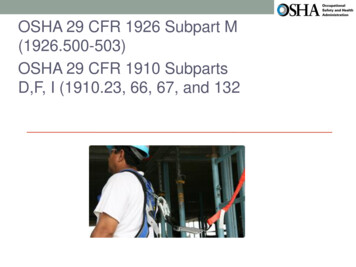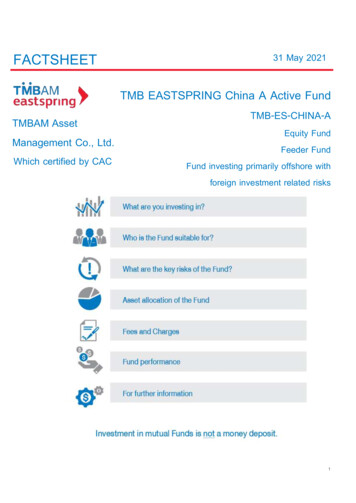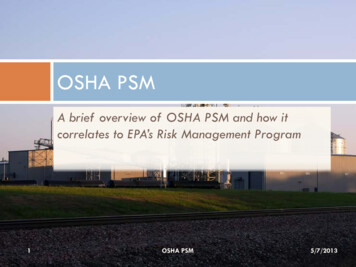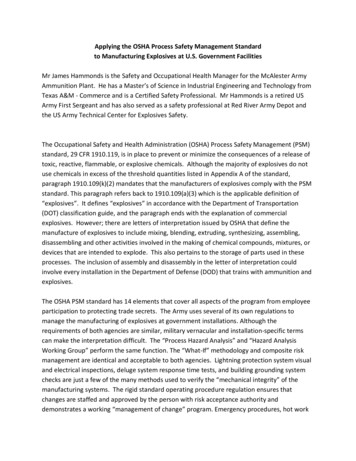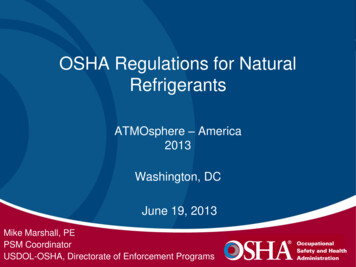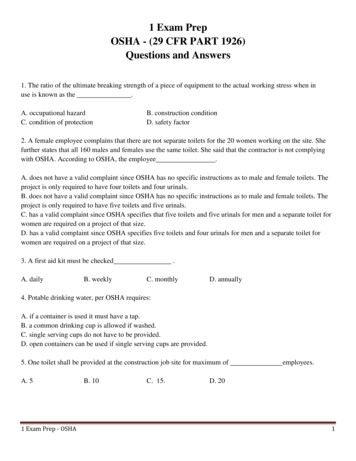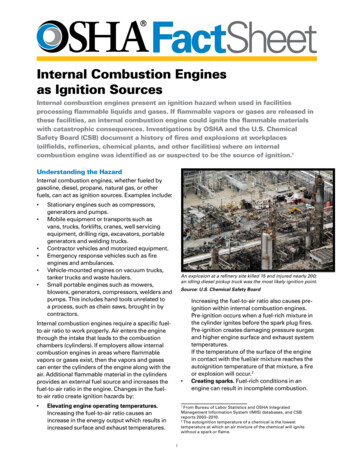
Transcription
FactSheetInternal Combustion Enginesas Ignition SourcesInternal combustion engines present an ignition hazard when used in facilitiesprocessing flammable liquids and gases. If flammable vapors or gases are released inthese facilities, an internal combustion engine could ignite the flammable materialswith catastrophic consequences. Investigations by OSHA and the U.S. ChemicalSafety Board (CSB) document a history of fires and explosions at workplaces(oilfields, refineries, chemical plants, and other facilities) where an internalcombustion engine was identified as or suspected to be the source of ignition.1Understanding the HazardInternal combustion engines, whether fueled bygasoline, diesel, propane, natural gas, or otherfuels, can act as ignition sources. Examples include: Stationary engines such as compressors,generators and pumps.Mobile equipment or transports such asvans, trucks, forklifts, cranes, well servicingequipment, drilling rigs, excavators, portablegenerators and welding trucks.Contractor vehicles and motorized equipment.Emergency response vehicles such as fireengines and ambulances.Vehicle-mounted engines on vacuum trucks,tanker trucks and waste haulers.Small portable engines such as mowers,blowers, generators, compressors, welders andpumps. This includes hand tools unrelated toa process, such as chain saws, brought in bycontractors.An explosion at a refinery site killed 15 and injured nearly 200;an idling diesel pickup truck was the most likely ignition point.Source: U.S. Chemical Safety BoardInternal combustion engines require a specific fuelto-air ratio to work properly. Air enters the enginethrough the intake that leads to the combustionchambers (cylinders). If employers allow internalcombustion engines in areas where flammablevapors or gases exist, then the vapors and gasescan enter the cylinders of the engine along with theair. Additional flammable material in the cylindersprovides an external fuel source and increases thefuel-to-air ratio in the engine. Changes in the fuelto-air ratio create ignition hazards by: Elevating engine operating temperatures.Increasing the fuel-to-air ratio causes anincrease in the energy output which results inincreased surface and exhaust temperatures.Increasing the fuel-to-air ratio also causes preignition within internal combustion engines.Pre-ignition occurs when a fuel-rich mixture inthe cylinder ignites before the spark plug fires.Pre-ignition creates damaging pressure surgesand higher engine surface and exhaust systemtemperatures.If the temperature of the surface of the enginein contact with the fuel/air mixture reaches theautoignition temperature of that mixture, a fireor explosion will occur.2Creating sparks. Fuel-rich conditions in anengine can result in incomplete combustion.From Bureau of Labor Statistics and OSHA IntegratedManagement Information System (IMIS) databases, and CSBreports 2003–2010.2The autoignition temperature of a chemical is the lowesttemperature at which an air mixture of the chemical will ignitewithout a spark or flame.11
Whenever possible, do notinstall permanently-mountedinternal combustion enginesin areas where flammablevapors or gases could bepresent.When uncombusted fuel from the cylindersenters the exhaust system, it can ignite due tothe hot surface, discharging sparks and flames(backfire). These can ignite flammable vaporsand gases in the surrounding area.Causing overspeed and runaway engines.Overspeed occurs when flammable vaporsand gases in the intake air cause engines to runfaster than designed. This increases the wearand tear on the engine, causing overheatingand risking autoignition. If allowed to continue,overspeed can result in mechanical failurecausing the engine to blow apart, ignitingflammable materials in the area and causing aflash fire or explosion.If employers cannot removeinternal combustion enginesfrom areas processingflammable materials, thenthe following preventivemeasures should be used.These measures includeadministrative proceduresfor the safe use of portableor mobile equipment withinternal combustion engines.The OSHA General Industryand Construction standardscontained in Subparts S and K(29 CFR 1910.307 and29 CFR 1926.407) of the Codeof Federal Regulations (CFR)define hazardous (classified)locations as areas with: Flammable gases or vapors(Class I) Combustible dust(Class II) Easily-ignitable fibers(Class III)In Class I locations, aninstallation must be classified asusing the division classificationsystem complying withparagraphs (c), (d), (e), and (f),or using the zone classificationsystem specified in paragraph(g), of 29 CFR 1910.307 or29 CFR 1926.407.Control Measures toReduce Risk Ensure that materials and equipment are storedand used in accord with OSHA standards suchas:o 29 CFR 1910.106 or 29 CFR 1926.152,Flammable liquids;o 29 CFR 1910.107, Spray finishing usingflammable and combustible materials;o 29 CFR 1910.119 or 29 CFR 1926.64, Processsafety management of highly hazardouschemicals;o 29 CFR 1910.178, Powered industrial trucks. Ensure that worksite safety programs and safework permit systems:o Address internal combustion engines asignition sources;o Evaluate and establish acceptable areas,boundaries, and entry routes for mobileThree workers were killed and four injured in a fire resulting from arunaway diesel engine.Source: U.S. Chemical Safety BoardFor a gasoline engine, overspeed is stopped byturning off the ignition switch, which shuts downthe ignition source (spark plugs) in the cylinders.This is not the case for diesel engines. Dieselengines do not use spark plugs; turning off theengine ignition switch does not shut down theignition source. Stopping the fuel supply is alsoineffective because the fuel is present in the intakeair. The only way to prevent mechanical failure andpossible explosion is to cut off the intake air supply,using systems such as automatic engine overspeedshutdown devices.Preventing Engines from BecomingIgnition SourcesWorkplace Evaluation Identify areas where flammable liquids orgases are used or stored. Evaluate where internal combustion enginesare located. Assess contractor use of internal combustionengines in flammable material areas.An idling diesel pickup truck believed to have ignited a vapor cloudfrom a nearby process area.Source: U.S. Chemical Safety Board2
internal combustion engines based onapplicable standards and recognized andgenerally accepted good engineeringpractices;o Mark and enforce acceptable traffic routesthrough hazardous (classified) locations;o Account for special procedures, which mightinclude the use of portable gas monitors, oremergency evacuation routes for vehicles.Use other preventive measures such as:o Installing automatic overspeed shutdowndevices on permanently-mounted engines.o Installing intake flame arrestors and exhaustsystem spark arrest systems on permanentlymounted engines.o Installing flammable gas and vapor detectorsin processing areas.o Installing shutdown systems (positive airshut-off for diesel or ignition kill for gasoline),intake flame arrestor, exhaust system sparkarrest, or other appropriate protectivesystems3 for mobile internal combustionengines.o Using a safe work permit system to controlmobile combustion engine access into areasthat could contain flammable vapors andgases.o Using a safe work permit system to controlthe use of open flames and spark-producingoperations and equipment (e.g., welding,grinding, brazing, etc.) Standards andResourcesThe Process Safety Management(PSM) standard(29 CFR 1910.119) applies toprocesses in facilities that haveflammable liquids or gases onsite in one location in a quantityof 10,000 pounds or more. Forcovered processes, the PSMstandard addresses controllingignition sources primarily byrequiring employers to: Compile written processsafety information forworking with hazardouschemicals, includingidentifying areas whereflammable materials are ormay be present, 29 CFR1910.119(d). Complete a process hazardanalysis that addresses thehazards of the process,including control of ignitionsources such as internalcombustion engines, 29 CFR1910.119(e). Develop and implement safework practices, includingcontrol of vehicle accessto process areas, 29 CFR1910.119(f)(4). Develop and implementwritten procedures (f) andtraining for operators (g),maintenance personnel (j),and contractors (h), 29 CFR1910.119(f), (g), (h), and (j). Control hot work, 29 CFR1910.119(k).In addition to followingapplicable OSHA standards, employers should alsorefer to the American Petroleum Institute (API), theNational Fire Protection Association (NFPA), andother applicable industry and consensus standards,which provide helpful guidance.TrainingProvide training to workers and contractors onhazards in areas that contain flammable vapors andgases. The training should include instruction on: Areas, boundaries andacceptable routes formobile engines, andapplicable facility safetyrules. Instruct workersto avoid driving in areaswhere flammable vaporsand gases may be present,to stay on acceptableroutes, and to follow siteprocedures for safe accessin areas where flammablematerials are beingprocessed.Signs and hazards offlammable vapor and gasclouds, and associatedprecautions.Signs and hazards ofinternal combustionengine overspeed andrunaway.Emergency proceduresfor flammable materialsemergencies, includingresponse to engineoverspeeds and runaways.Hazards of internal combustion engines asignition sources and the specific worksite areasthat are subject to these hazards.1.2.3.4.5.One of two vacuum truck diesel engines believed to be theignition source for a fatal fire at an open air collection pit.Source: U.S. Chemical Safety BoardForklifts require specific unit ratings to be used. See29 CFR 1910.178.33OSHA Standard 29 CFR 1910.106, Flammableliquids: 29 CFR 1910.106(e)(6)(i), (f)(6), and (h)(7)(i)(A), Sources of Ignition.29 CFR 1910.107, Spray Finishing UsingFlammable and Combustible Materials.29 CFR 1910.178(c)(2)(i), (ii), “Poweroperated industrial trucks shall not be usedin atmospheres containing hazardousconcentration of acetylene, butadiene, ethyleneoxide, and hydrogen . . .metal dusts . . .” Forother listed chemicals, only certain unit ratingsare allowed. See the standard for more details.29 CFR 1910.119, Process Safety Managementof Highly Hazardous Chemicals.OSHA - Petroleum Refinery Process SafetyManagement National Emphasis Program(CPL 03-00-010, dated 8/18/2009). Page A-55,Motorized Equipment. “Does the employerhave a safe work practice which it implements
6.7.8.9.10.11.12.13.for motorized equipment to enter operatingunits and adjacent roadways?”Mine Safety and Health Administration (MSHA)Standard 30 CFR 7.98 – Diesel Engine TechnicalRequirements. Requires explosion-proofdesign and a safety shutdown system, as wellas intake flame arrest and an exhaust systemspark arrest system. See also MSHA Standard30 CFR 36.23 – Engine Intake System.Department of Interior, Materials ManagementServices (MMS) 30 CFR 250.510, 250.610,and 250.803(b)(5)(ii). Requires diesel engineautomatic shutdown devices/systems.Coast Guard Standard 46 CFR 58.10-5. Requiresgasoline engine intake system backfire flamecontrol.American Petroleum Institute (API)Recommended Practice (RP) 54, RecommendedPractice for Occupational Safety for Oil and GasWell Drilling and Servicing Operations.o 6.1.15 “On land locations, vehicles notinvolved in the immediate rig operationsshould be located a minimum distance of100 feet from the wellbore . . .”;o 9.14.2 “Rig generators on land locationsshould be located at least 100 ft (30.5 m)from the wellhead upwind considering theprevailing wind direction to isolate a possiblesource of ignition ”;o 9.15.3 “Spark arrestors or equivalentequipment shall be provided on all internalcombustion engine exhausts located within100 ft (30.5 m) of the wellbore ”;o 14.2.3 “Gasoline engines and other possiblesources of ignition should be located at least100 ft (30.5 m) from the wellbore duringsnubbing operations ”;o 15.2.2 “Any engine within 100 ft (30.5 m) ofthe well (within 35 ft of the well for offshore)should not be operated during the drill stemtesting operations without having a heat andspark arresting system for the exhaust ”;o 18.3.1 “Where terrain permits, compressorsshould be located at least 100 ft (30.5 m)from the wellbore ”.API RP 7C-11F – Recommended Practices forInstallation, Maintenance and Operation ofInternal Combustion Engines.API RP 505 – Recommended Practice forClassification of Locations for ElectricalInstallations of Petroleum Facilities Classified asClass I, Zone 0, Zone 1 or Zone 2.API RP 2001 – Fire Protection in Refineries.API RP 2216 – Ignition Risk of s and Vapors by Hot Surfaces in theOpen Air.API RP 2219 – Safe Operations of VacuumTrucks in Petroleum Service.National Fire Protection Association (NFPA) 37– Installation and Use of Stationary CombustionEngines and Gas Turbines.NFPA 70 – National Electrical Code.NFPA 497 – Recommended Practice for theClassification of Flammable Liquids, Gases, orVapors and of Hazardous (Classified) Locationsfor Electrical Installations in Chemical ProcessAreas.NFPA 505 – Fire Safety Standard for PoweredIndustrial Trucks Including Type Designations,Areas of Use, Conversions, Maintenance, andOperations.NFPA FPH – Fire Protection Handbook.Diesel Engine Manufacturers Association(DEMA) – Standard Practices for Low andMedium Speed Stationary Diesel and GasEngines.California OSHA Standard, Subchapter 14,Article 35 – Petroleum Safety Orders – Drillingand Production.California OSHA Standard, Subchapter 15,Article 21 – Refining, Transportation andHandling – Gas Conveyors and Engines.Chemical Safety Board (CSB) InvestigationReport – BLSR Operating Ltd. Vapor CloudDeflagration and Fire, 2003. Also, see other CSBreports.Center for Chemical Process Safety (CCPS)Process Safety Beacon, October 2009.How Can OSHA Help?OSHA has compliance assistanc
9. American Petroleum Institute (API) RecommendedPractice(RP) 54, Recommended Practice for Occupational Safety for Oil and Gas Well Drilling and Servicing Operations. o 6.1.15 “On land locations, vehicles not involved in the immediate rig operations should be located a minimum distance of 100 feet from the wellbore . . .”; o 9.14.2 “Rig generators on land locations should be located at .
